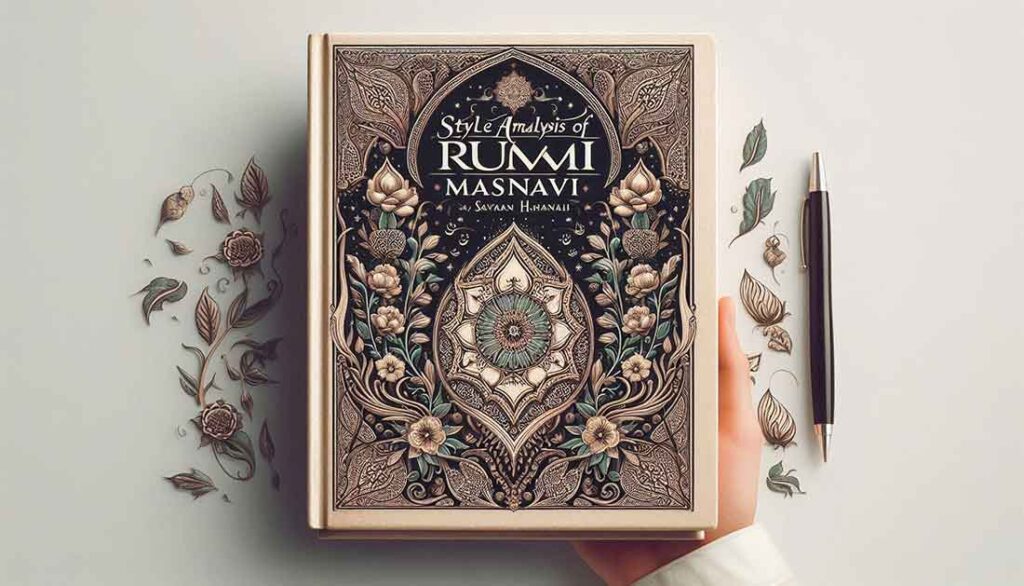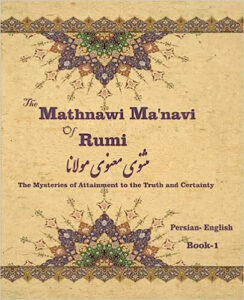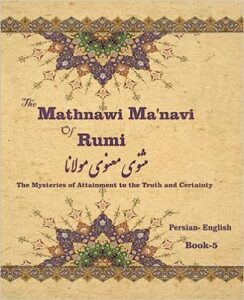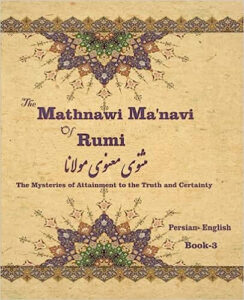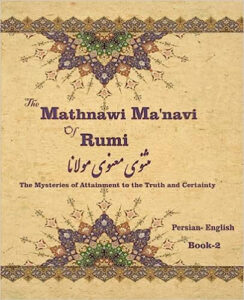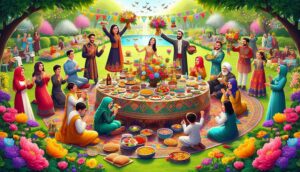Table of Contents
ToggleAnalysis of Masnavi
Jalal al-Din Muhammad Rumi, commonly known as Rumi, is one of the most celebrated Persian poets and mystics. His magnum opus, the “Masnavi,” also known as the “Mathnawi” or “Masnavi-i Ma’navi” (Spiritual Couplets), is a monumental work in the canon of Sufi literature. This extensive poem, written in rhyming couplets, delves into profound spiritual and philosophical themes. This article offers a comprehensive style analysis of Rumi’s Masnavi, exploring its poetic techniques, themes, and enduring impact on Persian literature.
Rumi’s Masnavi is often regarded as one of the greatest works of mystical poetry. Composed of six books and over 25,000 verses, it serves as a guide for spiritual seekers, offering insights into the nature of the divine, the human soul, and the path to enlightenment. Rumi’s unique literary style, characterized by its lyrical beauty and profound depth, has captivated readers for centuries.

Structure and Form
Rhyming Couplets (Masnavi)
The Masnavi is written in rhyming couplets, a form known as “masnavi” in Persian literature. Each couplet typically has a self-contained meaning, contributing to the poem’s overall narrative and thematic structure. The rhyme scheme of aa, bb, cc, and so on provides a rhythmic and musical quality to the verses, enhancing their lyrical appeal.
Narrative Technique
Rumi employs a narrative technique that intertwines stories, parables, and anecdotes to convey spiritual and moral lessons. This method allows him to explore complex ideas through simple, relatable tales. Storytelling makes the Masnavi accessible and engaging, inviting readers to reflect on more profound truths.
Thematic Elements
Divine Love and Union
One of the central themes of the Masnavi is the concept of divine love and the soul’s longing for union with God. Rumi’s poetry expresses an intense and passionate love for the divine, portraying it as the ultimate goal of human existence. This theme is woven throughout the Masnavi, illustrating the transformative power of love in the spiritual journey.
Example:
“I am the servant of the Quran as long as I have life. / I am the dust on the path of Muhammad, the Chosen One.”
The Human Condition
Rumi’s exploration of the human condition is another key theme in the Masnavi. He delves into the struggles, contradictions, and aspirations that define human existence. Rumi addresses the nature of the self, the conflict between ego and soul, and the quest for self-awareness and enlightenment through his poetry.
Example:
“The wound is the place where the Light enters you.”
Mystical Knowledge and Enlightenment
Pursuing mystical knowledge and enlightenment is a recurring motif in the Masnavi. Rumi emphasizes the importance of inner awakening and spiritual realization, often contrasting worldly knowledge with divine wisdom. His verses encourage readers to seek the truth beyond the material world and to embrace the inner journey toward enlightenment.
Example:
“Sell your cleverness and buy bewilderment.”
Symbolism and Imagery
Natural Elements
Rumi frequently uses natural elements as symbols to convey spiritual truths. Elements such as the sun, moon, water, and fire serve as metaphors for divine attributes and the soul’s journey. This use of natural imagery creates vivid and evocative pictures in the reader’s mind, enhancing the emotional and spiritual impact of the poetry.
Example:
“The water we seek is in the fountain of our own hearts.”
Animals and Objects
Animals and everyday objects also play symbolic roles in the Masnavi. For instance, Rumi often uses the imagery of birds to represent the soul’s flight toward spiritual freedom. Such symbols make abstract concepts more tangible and relatable, helping readers grasp complex spiritual ideas.
Example:
“The spirit is a bird held in the hand of the body.”
Language and Style
Lyrical Beauty
Rumi’s language is known for its lyrical beauty and musicality. His mastery of Persian allows him to craft aesthetically pleasing and deeply meaningful verses. The fluidity and grace of his language draw readers into the rhythmic flow of the poetry, creating an immersive and contemplative experience.
Use of Metaphor and Simile
Rumi’s poetry is rich with metaphors and similes that convey multiple layers of meaning. These literary devices enable him to express profound spiritual insights in a concise and powerful manner. The imaginative use of metaphor and simile also adds a dynamic and expressive quality to the verses.
Example:
“The heart is a candle longing to be lit by the Beloved’s light.”
Direct Address and Dialogue
Rumi often employs direct address and dialogue in the Masnavi, speaking directly to the reader or engaging in conversations with spiritual figures. This technique creates an intimate and immediate connection between the poet and the audience, making the themes more personal and impactful.
Example:
“Listen, O drop, give yourself up without regret, and in exchange gain the Ocean.”
Impact and Legacy
Influence on Persian Literature
The Masnavi has had a profound influence on Persian literature and Sufi thought. Its themes, style, and spiritual insights have inspired countless poets, scholars, and mystics. The work remains a cornerstone of Persian literary tradition, celebrated for its depth, wisdom, and artistic excellence.
Global Reach
Rumi’s poetry has transcended cultural and linguistic boundaries, gaining a global following. Translations of the Masnavi have introduced Rumi’s mystical vision to a wide audience, making his insights accessible to readers worldwide. The universal themes of love, spirituality, and human experience resonate deeply with people from diverse backgrounds.
Contemporary Relevance
In contemporary times, the Masnavi continues to be a source of inspiration and guidance. Its teachings on love, self-awareness, and spiritual growth are as relevant today as they were centuries ago. Rumi’s ability to address timeless human concerns ensures that his poetry remains a beacon of light for those seeking wisdom and enlightenment.
FAQs
What is the structure of Rumi’s Masnavi?
The Masnavi is written in rhyming couplets (Masnavi) with a rhyme scheme of aa, bb, cc, etc. It comprises six books and over 25,000 verses, combining stories, parables, and anecdotes to convey spiritual and moral lessons.
What are the main themes of the Masnavi?
The main themes of the Masnavi include divine love and union, the human condition, mystical knowledge, and enlightenment. Rumi explores these themes through rich symbolism, natural imagery, and lyrical language.
How does Rumi use symbolism in the Masnavi?
Rumi uses natural elements, animals, and everyday objects as symbols to convey spiritual truths. These symbols make abstract concepts more tangible and relatable, enhancing the emotional and spiritual impact of the poetry.
What is the significance of Rumi’s language and style?
Rumi’s language is known for its lyrical beauty, musicality, and rich use of metaphor and simile. His direct address and dialogue create an intimate connection with the reader, making the themes more personal and impactful.
How has the Masnavi influenced Persian literature and global thought?
The Masnavi has profoundly influenced Persian literature and Sufi thought, inspiring countless poets and scholars. Its universal themes have gained a global following, making Rumi’s mystical vision accessible to a broad audience.
Why is the Masnavi relevant in contemporary times?
The Masnavi remains relevant today due to its timeless teachings on love, self-awareness, and spiritual growth. Rumi’s ability to address universal human concerns ensures that his poetry continues to inspire and guide readers seeking wisdom and enlightenment.
Rumi’s Masnavi is a masterpiece of mystical poetry, offering profound insights into the human soul and its quest for divine love and enlightenment. Through its unique structure, rich symbolism, and lyrical beauty, the Masnavi continues to captivate readers and inspire spiritual seekers worldwide. Analyzing its style and themes deepens our understanding of Rumi’s poetic genius and the enduring impact of his work on Persian literature and beyond.

